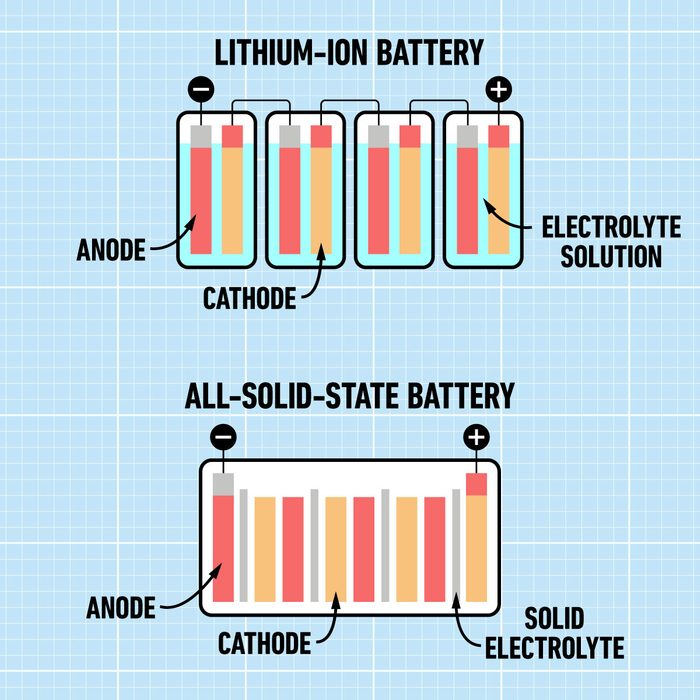What Is a Solid-State Lithium Battery?
Updated: Sep. 14, 2023

The next generation of rechargeable battery is starting to hit the market. Here's what to know about solid-state lithium and where to find it.
Our editors and experts handpick every product we feature. We may earn a commission from your purchases.
Learn more.
There’s liquid inside your phone, your computer and your electric vehicle (EV). That’s because nearly all rechargeable electronics use lithium-ion batteries, which rely on liquid electrolytes.
But that’s about to change.
“Though solid-state lithium batteries were developed more than 30 years ago, their commercial use is just taking off thanks to new materials that are making them commercially viable,” says Vince Caito, vice president of product development at Yoshino Power. “Solid-state is especially making headlines as auto manufacturers develop them for the next generation of EVs.”
On This Page
What Is a Solid-State Lithium Battery?
Simply stated, a solid-state lithium battery uses a solid electrolyte instead of a liquid one.
“All batteries have three main components: anode, cathode and an electrolyte,” says Gabriel Adams, a student at Arizona State University researching the new technology at the Rolston Lab.
“In the widely popular non-solid-state lithium batteries found in everything from consumer electronics to airplanes, the electrolyte is a liquid that facilitates lithium-ion transfer between the anode and cathode. In a solid-state lithium battery, the electrolyte is a solid material instead.”
There are several kinds of solid-state lithium battery technologies. Some rely on polymers to conduct the lithium ions, while others use sulfides or oxides (ceramics).
Advantages of Solid-State Lithium Batteries
Improved safety is one major advantage, because the electrolytes can’t leak out.
“Liquid electrolytes are flammable, and that’s why you see battery fires in the news,” says Eric D. Wachsman, Ph.D., director of the Maryland Energy Innovation Institute.
“We can engineer around it, and have been doing that for a long time, but there are certain fundamental tradeoffs between safety and performance with liquid electrolytes and the ceramic solid electrolytes avoid that tradeoff because the solid is non-flammable.”
Another advantage: The higher energy density, resulting in a more compact and lighter battery. With EVs, this has been touted as the “Holy Grail,” because it allows cars to go farther on a charge and recharge more quickly.
For the techies out there, here’s why, according to Adams: “Solids are more dense than liquids, and solid-state batteries eliminate the need for a separator between the anode and cathode. They also have better thermal stability because solids are more tightly bound together at the atomic level, so solid-state batteries can better withstand higher temperatures.”
Disadvantages of Solid-State Lithium Batteries
The biggest disadvantage is cost, due to their advanced materials, technology and manufacturing complexities. But as these batteries become more common, costs are likely to come down.
Where Are Solid-State Batteries Being Used?
Currently they’re not widely available to consumers, but that’s starting to change. Yoshino Power just released some of the first solid-state lithium products: portable power stations in various sizes for home backup, running power tools and camping. Over the next few years, the technology is expected to start storming the EV market.
“Solid-state batteries are the way of the future,” says Adams. “New electric vehicle manufacturers are investing heavily in their development, and companies like Toyota have claimed their new electric vehicles will use solid-state battery technology as soon as 2027.”
Nearly every other auto manufacturer has also made a commitment toward the technology.
“The focus from the Department of Energy in terms of funding has been in electric vehicles because of the impact on addressing climate concerns,” says Wachsman. “But it will make it into consumer electronics. It will make it into grid storage. There’s a limitless number of applications for these batteries.”
But if you’re considering an EV and you’re on a budget, don’t wait for the technology to come out. “Just go get it now,” says Wachsman. “The initial ones are going to be more expensive, and it’s going to be a while before the scale of manufacturing is large enough that the price per unit drops.”
